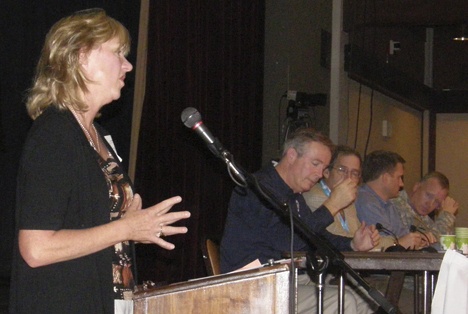With the approach of fall, local and federal warnings are coming fast and furious now about the Howard Hanson Dam’s ability to hold back the waters of the Green River in the event of a flood.
A standing-room-only crowd packed Green River Community College’s Lindbloom Student Center last week to hear officials warn and advise, part of a massive public outreach campaign to ensure that valley residents and businesses are prepared for what might come.
“That dam was built many years ago to protect the valley from flooding, and this year we can’t count on it,” said King County Councilmember Julia Patterson.
The January storms resulted in a record pool of water behind the dam, a pool that rose to more than three quarters of the dam’s holding capacity, higher than it had ever held in its 47-year history.
In the storm’s wake, the U.S. Army Corps of Engineers, which operates the dam, found two depressions in the dam’s right bank or abutment, an earthen structure made from 20,000-year-old landslide material. Those holes have reduced the dam’s holding capacity.
Col. Anthony Wright, district commander of the U.S. Army Corps of Engineers in Seattle, said the evidence gathered so far shows the dam is not in danger of failure. But he said that a high enough pool could be enough to cause a failure, and that to prevent such a catastrophe, he would have to release water down the Green River.
“The challenge we have is that it can still be operated as a flood-control structure, but it doesn’t have the capacity it used to, and I can’t take the risk of filling it up and hoping that it works,” Wright said. “I can’t let it get very high because I have a lot less flood risk capacity. To keep it from getting so high that it endangers the structure, I am going to release more water.”
Wright put the odds of flooding this rainy season at one in three.
The levee system along the river was designed with the dam in mind. It is designed to handle about 12,000 cubic feet of water per second, not uncontrolled water flows. Wright said the levees have been “run hard” the last few seasons.
Temporary repairs to the abutment in the form of a grout curtain are under way and slated to be completed by Nov. 1. And while the curtain will have some effectiveness, it won’t bring the dam back to full capacity, Wright said.
Work is going on 24 hours a day as workers drill spaced, 160-feet-deep plus holes and pump the grout or cement into them. These grout-filled holes tie into the ground and run along the abutment to slow seepage.
“It’s not going to stop all the water from flowing. To do that, we would have to put in a cut-off wall,” Wright said.
The multi-million dollar cut-off wall project is in the planning stages but is at least three to five years away. Wright said the cutoff wall would restore the dam to its full design capacity as a flood control structure.
The Corps is also installing a series of filter drains that come in from the drainage tunnel under the abutment to control the level of water and where it flows to prevent it from undermining the structural integrity of the abutment. The effectiveness of the repairs will be tested when the Corps refills the pool next spring.
“We think this is going to work, but it might not,” said Wright. “If Mother Nature rolls a six for us, you need to be ready.”
Steve Bleifuhs, manager of King County’s floodplain management program, said the county will open its Flood Warning Center early and will have more staff than it ordinarily has out inspecting the levees.
“We are going to have a lot of people out looking for early signs of problems with the levees, including seepage,” Bleifuhs said.
Bleifuhs said the county is testing its new automated caller system, which will be used to warn people. He urged everybody to have a disaster plan ready and to buy an emergency radio.
“It’s essential that you do it. Work with your family and neighbors, have a place you can go after a flood event because it may be weeks before you can actually get back to your house,” Bleifuhs said.
Jeff Woodward, Federal Emergency Management Agency (FEMA) Region 10 spcialist, urged everybody to buy flood insurance.
====
A graphical depiction of the potential results of a flood in the valley is attached, courtesy of Depiction, Inc., www.depiction.com



